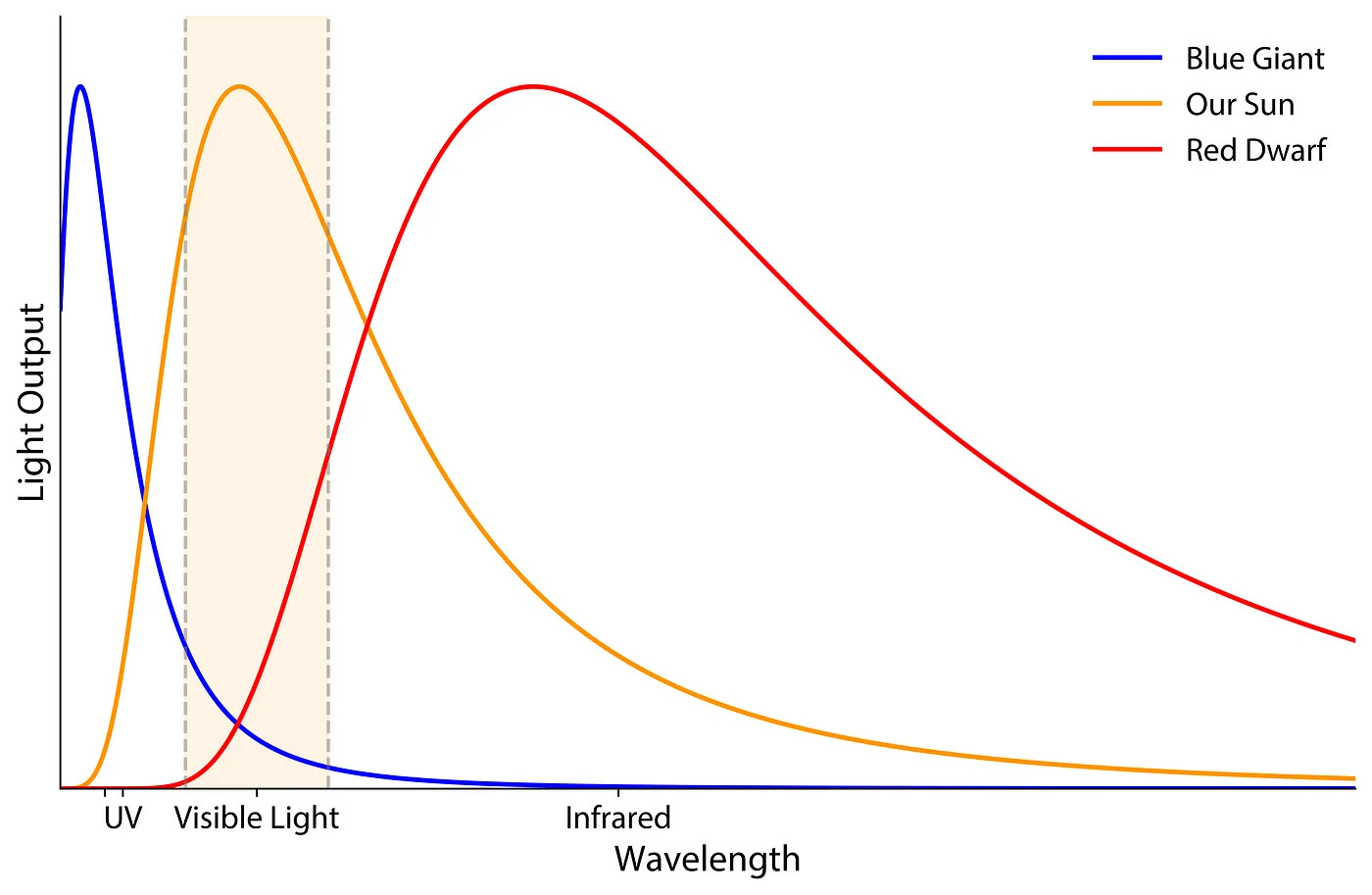Five Interesting Tidbits
Initially I wanted to write a whole post about the first topic, but decided it didn’t need one. So, five interesting tidbits:
Digital nomads could create network states (Substack post from Elle Griffin): I already foreshadowed that with refugees in “The Replicant, the Mole & the Impostor’);
I sold a story to Underland Arcana #12;
Who would’ve thought that: offloading cognitive work to AI reduces our own intelligence;
Hue new? Scientists claim to have found colour no one has seen before;
1—The (Un-)Surprising Reason Water is Transparent.
While the frequency output of the Sun nicely matches the frequency absorption of water, there are some other things to consider:
4-8% of all stars are like the Sun;
Our galaxy alone has 400 billion stars;
Meaning at least 16 billion stars are like the Sun;
Water—H2O—is very common;
So solar systems with a sun like Sol and water are—pessimistic estimate—at least one billion in our galaxy alone;
Finally, the habitable zone: according to Wikipedia (Planetary habitability), ‘at least 500 million’ are in the habitable zone (in the Milky Way);
Thus—worst case scenario—4% of those are in a system with sun-like stars: about 20 million;
And suppose only one in 10 has sufficient amounts of water—pessimistic estimate, as Paul Sutter of Universe Today states that ‘water is the most common chemical molecule found throughout the entire universe’—then there are well over two million planets with sufficient amounts of water in the habitable zone of a Sol-like star in the Milky Way;
Of course, what I’m doing is going down the first four factors of the Drake equation. Therefore, I think it’s not surprising that water is transparent to a range of light that we are able to see. Water’s light absorption is determined by the laws of nature, and so is our sun’s output. Yet the combination of a G2V type main sequence star (G2V) in combination with a planet in the habitable zone that contains water is not rare, as I estimate there are at least two million of such combinations in our galaxy alone (most optimistic scenario: about forty million).
Now more circumstances are needed for life (as we know it) to evolve—including volcanic activity and plate tectonics2—but the chances look good.
2—Digital Nomans could create network states.
Elle Griffin linked to this piece by on The Elysian Olivier Roland.
What can I say but I like the idea at first sight. So much that I used it in my serialised novel “The Replicant, the Mole & the Impostor” (which some of you may have read). In my novel, refugees—who one could also view as ‘digital nomads’—set up3 a network they call the ENE—Evolving Nisi Ethicality—as an online community for refugees with internet access4.
On top of that, as immigration laws get more strict, refugees have a much higher incentive than the (mostly) western digial nomads in Roland’s article. However—spoiler alert—the refugees in my novel eventually settle on an unoccupied island, while the western digital nomands of Roland’s article will have to settle in a country. Basically, this is already happening (without needing a ‘market state’) and causing gentrification—meaning this type of digital nomads are part of the problem , not of the solution. Tax ‘em higher, I’d say, and use that money to build affordable housing for your own citizens.
3—I sold a story to Underland Arcana #12
The contract has been signed and counter-signed, so I can say I’ve sold a story to Underland Arcana #12 called “Be Careful What You Wish For”. It’s my third sale to Mark Teppo (one of the few editors who seems to ‘get’ my writing5) after “Follow Me Through Anarchy6” in XIII7 and “Planet Preservation and the Art of Zen” in Underland Arcane #4). Hopefully to be released soon.
4—Offloading cognitive work to AI reduces our own intelligence (via The Guardian).
To which my reaction is: Duh! Who would’ve thought that?
It’s why I only use AI (Grammarly) for copy-editing after I’ve finished a piece of work, as it points out the small (spelling and grammar and usage) mistakes I make, not the big ones. The big decisions—theme, plot, narrative, style, characters, and whatnot—I always make myself, because this keeps me sharp.
Basically, I absorb a huge amount of information on topics that interest me (and I’m interested by a wide range of topics) and then stew over it for months or even years before I decide if this is sufficient for a short story/novelette/novella/novel. Then I start wrting it, and it also changes constantly during the writing, as my knowledge develops8.
TL;DR: I am in charge of the big picture, not an AI.
Let the AI aficionados ‘prompt engineer’ until their fingers are sore from typing (or their voices hoarse from dictating), the work so created will never have a voice, a vision, let alone a soul.
5—Hue new? Scientists claim to have found colour no one has seen before (Via The Guardian).
Ideally, colour is the quale our brains generate9 when our colour-sensitive cones are hit by light of certain wavelengths10. Roger Orpwood has described a compelling way in which such a process can work. As such, colour as such does not exist in reality, but is an imaginary quality that exists only in our brains (and that of many animals).
Therefore—IMHO—scientists claiming to have created a new colour by stimulating the M(edium) cones in the retina in a decisively unnatural way are more like high-tech drug dealers introducing a new type of acid11 than scientists performing an experiment that can be independently replicated on technical equipment.
It’s been imagined in different ways in science fiction, of course. I’ve had a story published where the protagonists are able to see—really, interpret—new colours in the infrared range after a genetic modification that adds a new type of cones12. I sold it twice, but had to pull the story from the first publisher as their editor wanted to cut the part where I intended to describe the process of those new types of colurs arising, because it was ‘too experimental’ (rolls eyes). If it’s groundbreaking, of course it’s experimental. Thankfully, the second market liked that part and proposed editorial changes that made sense (which I then followed). It also paid more, so there…;-)
Support this writer:
Like this post!
Re-stack it using the ♻️ button below!
Share this post on Substack and other social media sites:
Join my mailing list:
Author’s note:
(Un-) part added by me, as will become clear;
This Nautilus article called “The Odds that Aliens Existed just Got Worse” mentions: “Without plate tectonics, continents would quickly be eroded to sea level.” The it mentions that “…Venus and Mars show no evidence of sbduction…”, so how come that Olympus Mons is more than twice as high as Mount Everest?
This is preceded by the invention of a virtual area called a ‘moodscape’ by said refugees, which—amongst other things—generates considerable income;
Which is already about 90%, as smartphone mobile network subscriptions are 7.4 billion in 2025, on a world population of 8.2 billion, and set to rise to almost 8 billion by 2028 (when the world population is projected to be about 8.4 billion (so a coverage of about 95%);
In the acceptance note, he said ‘I do love the density of your stories’;
Title stolen—sorry, ‘borrowed’—from the chorus of “Patriot” on Damn the Machine’s superb debut album;
Where Publisher’s Weekly and Tangent Online don’t quite ‘get’ my story, unfortunately;
It’s why a novel is never really finished, but abandoned (at what one hopes is the right moment);
It’s very consistent over the majority of people, so is most likely an evolutionary trait;
It’s why that range of wavelengths is called ‘visible light’;
In the upper layer of the atmosphere of Venus, which is mostly CO2. Also, Carbon Dioxide Absorbs and Re-Emits Infrared Radiation, so expanding one’s area of ‘visible light’ into the infrared range would be very beneficial over there (which brings us back to tidbit 1: what light wavelengths water does—and does not—absorb;








